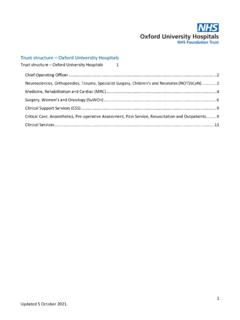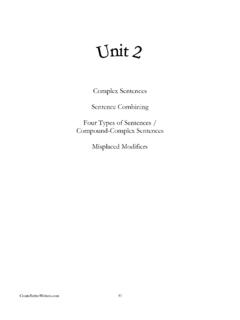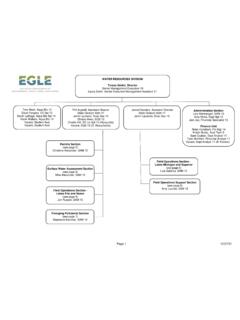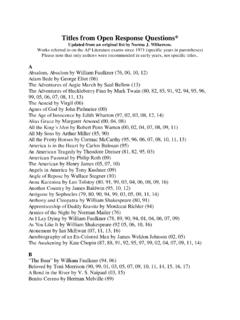Transcription of DSM-5: Trauma and Stressor Related Disorders
1 DSM-5: Trauma AND. Stressor Related . DIAGNOSES. dawn ELLISON, DPC, LPC, NCC. KATE HILTON, DPC, LPC, NCC. FONDREN INSTITUTE FOR PSYCHOTHERAPY. Trauma TRAINING. Counselors should understand the effects events on persons of all ages (CACREP, 2009, p. 10). Council for Accreditation of Counseling and Related Educational Programs (CACREP) emphasizes in both master's and doctoral training levels the importance of understanding the implications of Trauma theory, research and practice in counselor preparation and practice. CACREP standards incorporate Trauma training within all 8 core areas of knowledge and within each core counseling track.
2 Trauma IN THE. DSM. In layman's terms, Trauma typically refers to both the event that produces distress and the ensuing distress in an individual (Briere & Scott, 2006). Trauma -and- Stressor - Related diagnoses presuppose exposure to traumatic event (APA, 2013). What counts as a traumatic event? DSM-III combat, violent assault, natural disasters (outside the range of usual human experience). DSM-III-R expanded to include learning about or witnessing friend or family member exposure to life- threatening event DSM-IV-TR. Defined a traumatic event as: Involving actual or threatened death or serious injury or threat to one's physical integrity to self or other (Criterion A1).
3 Witnessing or learning about event Subjective feeling of intense fear, horror or helplessness (Criterion A2). Sudden and unpredictable Shocking in nature (APA, 2000). DSM-5. Traumatic event is described as exposure to actual or threatened death, serious injury, or sexual violence Adds experiencing repeated or extreme exposure to aversive details of the traumatic event (collecting human remains; police officers repeatedly exposed to details of child abuse). Specifies repeated exposure is not through electronic media, television, movies, or pictures unless exposure is work Related (APA, 2013).
4 Developmentally inappropriate sexual experiences without physical violence or injury (children). Trauma & Stressor . Related DIAGNOSES. Posttraumatic Stress Disorder Acute Stress Disorder Adjustment Disorders Reactive Attachment Disorder Disinhibited Social Engagement Disorder Other Specified Trauma - and Stressor - Related Disorder Unspecified Trauma - and Stressor - Related Disorder PTSD IN DSM-5. No longer Anxiety Disorder not all traumatizing events are fear based Criterion A2 (response involves fear, helplessness, or horror ) removed from DSM-5. 3 clusters are divided into 4 clusters in DSM-5.
5 Avoidance Intrusion / Re-experiencing Persistent negative changes in mood and cognition Arousal 3 new symptoms were added Other symptoms revised to clarify symptom expression All symptoms must have onset or significantly worsened after the traumatic event (DSM-IV only 7 symptoms explicitly tied to event). Separate diagnostic criteria for preschool (children 6 years or younger). New dissociative subtype for PTSD added CHANGES TO CRITERION A. Criterion A was expanded to include sexual violence Indirect exposure (A3) was modified: learning about what happened event must be accident or violent; added A4 repeated extreme exposure to details (first responders, police, military mortuary workers, mental health / Trauma clinicians media exposure is excluded).
6 Eliminated sudden death of a loved one due to natural / medical causes (Friedman, 2013). CHANGES TO CRITERION B. Criterion B: Intrusion Same 5 symptoms as DSM-IV-TR. Endorse at least 1. The memory of the Trauma is at the heart of the diagnosis and the organizing core around which all of the other symptoms can be understood (Friedman, 2013, ). B1: Memories Applies only to distressing involuntary here and now recollection (sensory /. emotional component). Versus DSM-IV-TR ruminations / recollections (images, thoughts, perceptions). B2: Nightmares Includes Trauma Related dream content as well as instant replay of event B3: Flashbacks Emphasis on dissociation and continuum of reactions (partial to total loss of awareness).
7 Note: In children look for repetitive play/ Trauma specific reenactment CHANGES TO. CRITERION C. CRITERION C: Avoidance Numbing separated from avoidance (moved to Criterion D). From 7 symptoms to 2 symptoms; endorse at least 1. C1: Avoid internal reminders (memories, thoughts, feelings, talking about event). C2: Avoid external reminders (activities, objects, situations, or people). CHANGES TO CRITERION D. CRITERION D : Negative alterations in cognition and mood (APA, 2013). Changes in self or other appraisals and mood that began or worsened since event Numbing symptoms from DSM-IV-TR plus two new symptoms D1: Amnesia about aspects of event(not due to TBI or intoxication).
8 D2:Negative beliefs (broader version of previous foreshortened future ). belief the self, world, future has been irrevocable altered because of the event D3: Distorted cognitions and beliefs about blame (self / other) about causes or consequences of event D4: Negative emotions / mood state (fear, horror, anger, guilt, shame). D5: Diminished interest D6: Detachment or estrangement D7: Inability to experience positive emotions CHANGES TO CRITERION E. CHANGES TO CRITERION E: Arousal and Reactivity Formerly hyperarousal cluster (Criterion D). Now encompasses behavioral reactivity to account for externalizing symptoms (aggression, recklessness, suicidality).
9 Similar to DSM-IV but with one new symptom: E1: Irritable behavior and angry outbursts (distinguish between angry mood and angry behavior). E2: Reckless or self-destructive behavior (new emphasis on behavior). Ex: reckless driving, excessive alcohol use, suicidal behavior, risky sexual behavior E3: Hypervigilance E4: Exaggerated startle E5: Problems with concentration E6: Sleep disturbance CHANGES TO. CRITERIA F-H. CHANGES TO CRITERIA F-G: None F. Duration is more than 1 month G. Clinically significant distress or impairment Added Criterion H: H.
10 Not attributed to the physiological effects of a substance or other medical condition. Specify With dissociative symptoms With delayed expression 6 months post event IN In DSM-5, PTSD is now a Trauma or Stressor - Related disorder initiated by exposure (direct /. indirect) to a traumatic event that results in intrusive thoughts, avoidance, altered cognition or mood, and hyperarousal or reactive behavior that lasts more than a month, causes significant distress, and is not the result of substance abuse or a medical condition. IMPLICATIONS FOR. ASSESSMENT.






